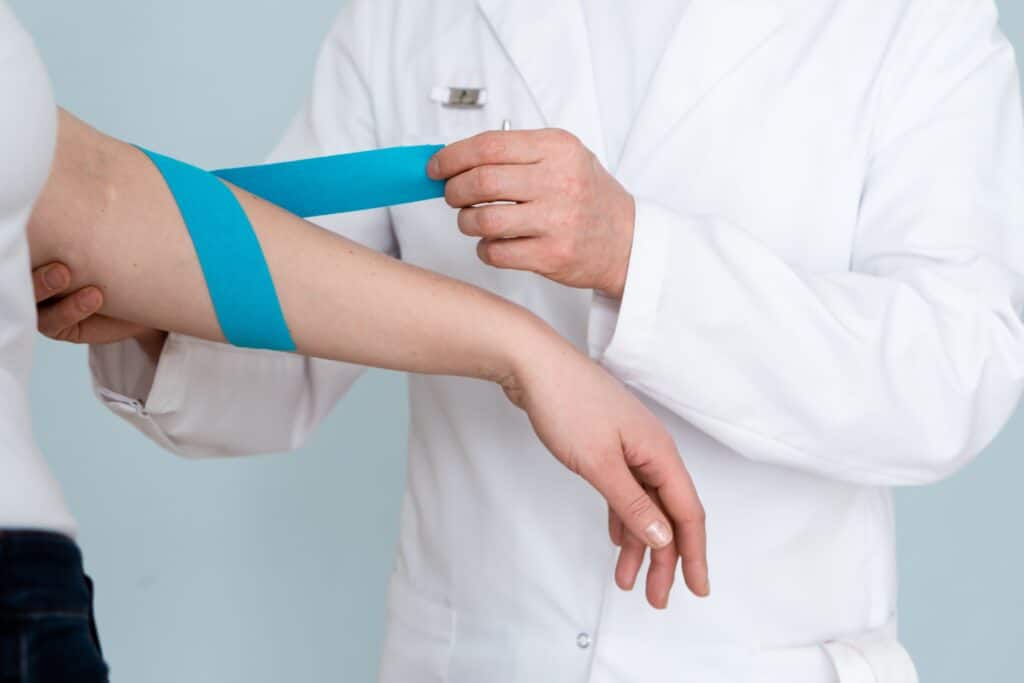
Kinesiology tape—often seen in bright colors on athletes—is an elastic therapeutic tape applied to the skin to support injured or overused muscles and joints. Unlike traditional athletic tape that restricts movement, kinesiology tape stretches and moves with the body. It can be worn during exercise, at work, or even in the shower. Its goal is to reduce pain, support mobility, and enhance the body’s natural healing process.
Now widely embraced beyond the sports world, this tool has become a regular part of orthopedic care, rehabilitation, and post-surgical management. It's not just for athletes either! Anyone can use kinesiology tape to help alleviate muscle tension.
Kinesiology tape works through a combination of mechanical support, neurological feedback, and circulatory benefits:
Together, these effects make kinesiology tape a powerful tool for both injury prevention and rehabilitation.
Kinesiology tape isn’t just for elite athletes and weekend warriors—it can also provide significant benefits for the everyday person. Whether you’re a busy parent, a desk worker, or someone recovering from a recent surgery, kinesiology tape can help manage muscle tension, reduce joint pain, and support better posture. It’s especially useful for those who spend long hours sitting or standing, as it can reduce muscle fatigue and encourage proper alignment, which helps prevent chronic aches and pains. Additionally, for people recovering from minor strains or joint instability, kinesiology tape provides gentle, targeted support and does so without restricting your movement, making it ideal for daily activities like walking, lifting, or even gardening.
By improving blood flow and lymphatic drainage, kinesiology tape can also aid in reducing your swelling and inflammation, which can be particularly helpful after minor injuries, long flights, or intense physical labor. Its lightweight, breathable design makes it comfortable enough for daily wear, whether you’re moving around the house, at the office, or enjoying outdoor activities. With proper application, kinesiology tape can help you stay active and pain-free, making it a valuable addition to any home health routine.
Kinesiology tape helps reduce discomfort in muscles and joints by unloading stress from the affected tissues. It can diminish nerve sensitivity and provide a gentle reminder to avoid overusing an injured area, helping you move more comfortably while healing.
Athletes and active individuals use kinesiology tape to add dynamic stability during movement. It reinforces key muscle groups and joints without limiting range of motion, which can prevent common overuse injuries like shin splints, runner’s knee, or rotator cuff strains.
The lifting effect of the tape helps lymphatic fluid move more freely, making it a valuable tool after surgery or injury. This can minimize swelling and bruising while supporting a quicker recovery by promoting fluid exchange and oxygen delivery.
Used in conjunction with physical therapy, kinesiology tape provides additional support during movement retraining. It helps correct faulty mechanics, provides neuromuscular cues, and protects healing tissues, allowing people to gradually return to activity with confidence.
Kinesiology tape can be applied to nearly any part of the body where muscles, joints, or ligaments need support. Common areas include the shoulders, knees, lower back, ankles, wrists, elbows, and calves. It can also be used for smaller, more precise areas like the neck or fingers. The versatility of KT tape makes it suitable for managing everything from correcting posture and muscle tension to joint instability and swelling, allowing it to address a wide range of orthopedic concerns.
Kinesiology tape can be used on a wide range of body parts to provide support, reduce pain, and improve function:
Ankle – Commonly used for ankle sprains and instability, kinesiology tape helps stabilize the joint, reduce swelling, and support natural movement during recovery. It’s ideal for athletes or anyone recovering from a twisted ankle or chronic instability.
Elbow – For conditions like tennis elbow or golfer’s elbow, tape can reduce strain on the muscles and tendons surrounding the elbow joint, helping to manage pain and improve grip strength.
Knee – Often applied for issues like runner’s knee or ACL support, kinesiology tape can help guide proper kneecap alignment, reduce pressure on the joint, and provide extra stability without restricting motion.
Shoulder – Ideal for rotator cuff strains, impingement, or general shoulder instability, taping this area can reduce muscle fatigue, enhance joint positioning, and prevent further injury during overhead activities.
Lower Back – For lumbar strain or posture correction, kinesiology tape can support the spinal muscles, reduce stress on the lower back, and promote better alignment, which is especially helpful for those who spend long hours sitting or lifting heavy objects.
This blog is for informational purposes only and does not constitute medical treatment, diagnosis, or individualized recommendations. Always consult with a healthcare provider or physical therapist for proper evaluation and tape application.

Most tape can be worn for 3–5 days. It’s water-resistant and designed to stay in place during showers or workouts.
It is safe for most individuals, but those with skin allergies, poor circulation, or medical implants should consult a healthcare provider first.
Yes, many applications—especially on knees, arms, or shins—are easy to do solo. For the back or shoulders, a friend or clinician may be needed to ensure proper placement.
When kinesiology tape is applied properly, you can get the most benefit from its support, pain relief, and circulation-enhancing properties. If you are considering having your healthcare provider apply tape here are a few things you should know:
Why: Oils, lotions, or sweat can prevent the adhesive from sticking properly, causing the tape to peel prematurely. For best results, clean the skin with soap and water, pat dry, and avoid applying lotion or sunscreen beforehand.
Why: While kinesiology tape is hypoallergenic, some people react to adhesives. Applying a small test strip behind the knee, inside the forearm, or over the shoulder blade can help you check for any itching, redness, or discomfort before full use.
Why: The adhesive needs time to fully bond with your skin. Avoid swimming, exercising, or showering for 30–60 minutes after application to ensure optimal sticking power.
Why: Pulling the tape off too quickly or against the hair grain can irritate the skin or cause tiny abrasions. Peel slowly, using lotion or warm water to ease removal if needed.
Kinesiology tape offers an accessible, effective tool for managing pain, promoting healing, and enhancing performance. From athletes to office workers to post-surgery patients, many have found it helpful for movement and recovery. When used appropriately, kinesiology tape can be a supportive ally in your health journey.
Our physical therapy specialists at ONJ’s orthopedic divisions can discuss integrating taping as part of your comprehensive rehabilitation program. Whether treating post-surgical patients, athletic injuries, or chronic joint conditions, our therapists can help you understand the use of tape to reduce pain, support weak muscles, and improve joint alignment without limiting mobility. By combining taping with targeted therapeutic exercises, we aim to accelerate recovery, enhance muscle performance, and reduce the risk of re-injury.